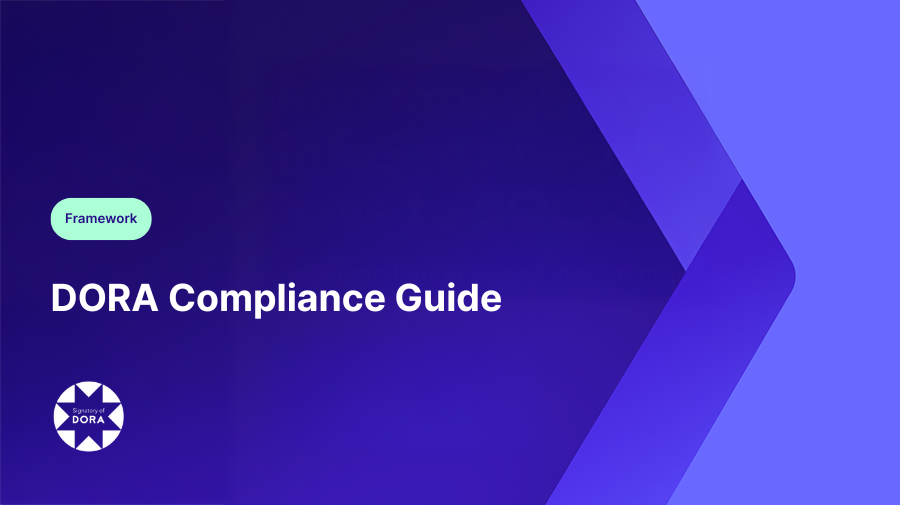Governance and monitoring
Documented framework, ownership, continuous risk assessment.
Define roles, metrics, and oversight. Align with ISO 27001 and NIST CSF where helpful.

The Digital Operational Resilience Act (DORA) has become one of the most important regulations for financial institutions across the European Union. It moves beyond cybersecurity hygiene and demands a complete, end-to-end view of operational resilience, ensuring that banks, insurers, and other financial entities can withstand, respond to, and recover from digital disruptions.
This guide outlines what DORA is, who it applies to, its key requirements, and how to approach compliance efficiently.
The Digital Operational Resilience Act (EU Regulation 2022/2554) is a European Union framework designed to strengthen the financial sector’s ability to manage and recover from ICT-related disruptions.
Rather than treating cybersecurity, incident response, and risk management as separate activities, DORA integrates them under one unified set of obligations.
The regulation covers everything from third-party risk to incident classification and testing, requiring institutions to maintain a constant level of operational readiness. Key goals include:
DORA went live in January 2025, and enforcement continues to roll out across national regulators.
DORA applies broadly to almost every organization in the EU’s financial ecosystem. This includes:
DORA applies not only to companies with an EU presence, but also to non-EU companies that support the vital operations of EU-based financial institutions.
DORA compliance will likely apply to your business if it has any role in data, systems, or processes that are necessary to the functioning of a financial institution.
DORA introduces five main pillars that define operational resilience in financial services:
Each pillar is interconnected. Strong ICT governance informs incident response; regular testing validates controls; and third-party management ensures resilience across the supply chain.
Implementing DORA compliance requires a combination of governance, technology, and continuous testing.
1. Assess your current state: map existing frameworks such as ISO 27001, NIST CSF, or SOC 2 to DORA’s five pillars. Identify overlaps and gaps to prioritize remediation.
2. Establish governance structures: define accountability. Senior management must approve and oversee the ICT risk management framework.
3. Strengthen monitoring and incident processes: automate detection, escalation, and reporting workflows. Ensure classification levels and regulator reporting timelines are clearly defined.
4. Evaluate and manage third-party risk: create an inventory of all ICT providers. Review contracts, assess risk levels, and confirm that each vendor’s security posture aligns with DORA obligations.
5. Plan and conduct resilience testing: schedule controlled scenarios and threat-led testing to validate response procedures. Document evidence for auditors and regulators.
6. Create a feedback loop: embed learnings from incidents, tests, and audits back into your policies and control framework.
With Complyance, teams can map controls across DORA’s five pillars, automate reporting, and gain AI-powered visibility into ICT dependencies.
DORA and NIS 2 both aim to strengthen resilience against digital threats, but their scope and application differ.
Many financial organizations will need to comply with both frameworks. Aligning them early helps reduce duplicate reporting and overlapping audits.
DORA raises the bar for operational resilience in financial services by turning resilience from an IT exercise into a core governance requirement.
It requires coordination across compliance, risk, and technology teams, and a shift from reactive risk management to continuous resilience validation.
Complyance helps financial institutions stay audit-ready under DORA by automating control mapping, evidence collection, and risk monitoring, creating a single source of truth for operational resilience.
Explore how Complyance helps automate DORA reporting and continuous resilience testing. Book a demo today.
When does DORA become fully enforceable? DORA came into full application in January 2025, but regulators expected progress and readiness by late 2024.
Does DORA apply to non-EU firms? Yes. If your services support EU-based financial institutions, you must comply with DORA’s third-party obligations.
How often do tests or risk assessments need to be performed? At least annually, with additional testing after major ICT or organizational changes.
What frameworks help with compliance alignment? ISO 27001, NIST CSF, and SOC 2 provide good alignment foundations for DORA controls.
